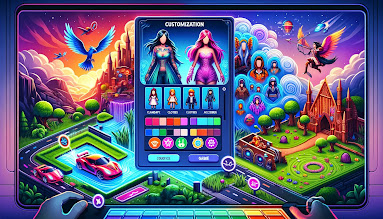In the rapidly evolving field of digital gaming, the integration of simulation
solutions and gamification solutions into various sectors has proven to
be incredibly beneficial, especially in educational and professional training
environments. Among the many features that contribute to the success of
these games, customization options stand out as a critical factor.
Customization in gamified simulation games enhances user engagement,
improves learning outcomes, and provides a more personalized
experience that meets diverse user needs.
Enhancing Engagement through Personalization
Customization options in gamified simulation games allow users to
tailor aspects of the game to their preferences and requirements. This
can range from adjusting the difficulty levels of tasks to selecting
different avatars or changing the game environment's aesthetic.
Personalization significantly enhances user engagement by making
the experience more relatable and enjoyable. For instance, in a
healthcare training simulation, allowing a medical student to choose
scenarios that reflect their specialization can make the learning
process more relevant and immersive.
Improving Learning Outcomes
Educational theories suggest that when learners have some control
over the learning process, they are more motivated and likely to engage
deeply with the content. In gamified simulation games, customization
can facilitate this by enabling learners to set their learning paths, pace,
and challenges. For example, a simulation game designed for project
management training could offer different project scenarios ranging
from construction to IT development, allowing learners to focus on
areas most relevant to their careers. This relevance not only keeps
learners engaged but also ensures that the skills acquired apply
to real-world scenarios, enhancing the practical value of the
simulation solutions provided.
Meeting Diverse User Needs
The ability to customize a game also addresses the varying needs of
a diverse user base. Users come with different backgrounds, learning
styles, and previous experiences. Customization in gamified simulations
allows these diverse needs to be met more effectively. For example,
gamification solutions that include customizable feedback systems
can adapt to provide more detailed feedback to novices while offering
concise, high-level feedback to more experienced users. This adaptive
feedback mechanism helps maintain an optimal challenge level for
each user, essential for keeping all players engaged and learning at
their best pace.
Supporting Continuous Improvement and
Scalability
From a developer's perspective, incorporating customization options into
simulation and gamification solutions not only satisfies current user needs
but also offers scalability for future enhancements. As user needs evolve
and new training requirements emerge, games can be easily updated or
expanded to include these new elements without needing to redesign the
entire game. This adaptability is crucial for maintaining the longevity and
relevance of the educational tools.
Conclusion
Customization options are vital in maximizing the effectiveness of gamified
simulation games. They enhance user engagement, improve learning
outcomes, meet diverse needs, and support scalability. By leveraging
these options, developers can create more dynamic and responsive
simulation solutions that are not only educational but also enjoyable
and highly applicable to real-world scenarios. As the demand for such
sophisticated training tools increases, the ability to customize will continue
to be a significant differentiator in the quality and success of gamification
and simulation offerings in various sectors.


.jpg)
.jpg)
No comments:
Post a Comment